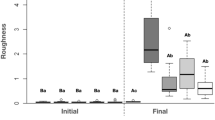Abstract
This study evaluated the surface roughness and Candida albicans adherence on denture base acrylic resins and silicone-based resilient liners with different surface finishes. Four commercial denture base acrylic resins (three heat polymerized and one room temperature polymerized) and five silicone-based liner materials (two heat polymerized and three room temperature polymerized) (10 × 10 × 2 mm) were tested in this study. The materials were processed against glass or plaster or finished with a tungsten carbide bur. Surface roughness measurements were made using a profilometer with an optical scanner probe. All specimens were ultrasonically cleaned in water for 15 s, autoclave sterilized, and contaminated with C. albicans solution for adherence assay evaluation. The materials processed against the glass surface showed significantly lower surface roughness values (0.11 ± 0.1–1.66 ± 1.1 μm) than those of the materials processed against the dental plaster (2.61 ± 0.2–6.12 ± 2.8 μm) or roughening with a bur (1.48 ± 0.2–7.05 ± 1.2 μm; p < 0.05, one- or two-way analysis of variance). Also, the materials processed against the glass surface showed lower C. albicans adhesion (mean ranks 120.36) than those of the materials processed against the dental plaster (mean ranks 139.77) or roughening with a bur (mean ranks 143.06), but the differences were not statistically significant (p > 0.05, Kruskal–Wallis and Mann–Whitney). In all types of surface finishes, C. albicans adhesion on denture base acrylics was significantly less (mean ranks 90.18–90.40) than those of silicone liners (mean ranks 119.38–205.18; p < 0.01, Kruskal–Wallis).
Similar content being viewed by others
References
Arendorf TM, Walker DM (1987) Denture stomatitis: a review. J Oral Rehabil 14:217–227
Baysan A, Whiley R, Wright PS (1998) Use of microwave energy to disinfect a long-term soft lining material contaminated with Candida albicans or Staphylococcus aureus. J Prosthet Dent 79:454–458
Budtz-Jorgensen E (1974) The significance of Candida albicans in denture stomatitis. Scand J Dent Res 8:1–47
Budtz-Jorgensen E, Bertram U (1970) Denture stomatitis I. The etiology in relation to trauma and infection. Acta Odontol Scand 28:71–92
Douglas LJ (1984) Surface composition and adhesion of Candida albicans. Biochem Soc Trans 13:467–469
Edgerton M, Scannapieco FA, Reddy MS, Levine MJ (1993) Human submandibular–sublingual saliva promotes adhesion of Candida albicans to polymethylmethacrylate. Infect Immun 61:2644–2652
Ellepola ANB, Samaranayake LP (1998) Adhesion of oral Candida albicans isolates to denture acrylic following limited exposure to antifungal agents. Arch Oral Biol 43:999–1007
Graham BS, Jones DW, Burke J, Thompson JP (1991) In vivo fungal presence and growth on two resilient denture liners. J Prosthet Dent 65:528–532
Gruber RG, Lucatarto FM, Molnar EJ (2001) Fungus growth of tissue conditioners and soft denture liners. JADA 73:641–648
Loney RW, Moulding MB (1993) The effect of finishing and polishing on surface roughness of a processed resilient denture liner. Int J Prosthodont 6:390–396
Loney RW, Price RBT, Murphy DG (2000) The effect of polishing on surface roughness of tissue conditioners. Int J Prosthodont 13:209–213
Minagi S, Miyake Y, Inagaki K, Tsuru H, Suginaka H (1985) Hydrophobic interaction in Candida albicans and Candida tropicalis adherence to various denture base materials. Infect Immun 47:11–14
Nikawa H, Hayashi S, Nikawa Y, Hamada T, Samaranayake LP (1993) Interactions between denture lining material, protein pellicles and Candida albicans. Arch Oral Biol 38:631–634
Nikawa H, Hamada T, Yamamoto T, Kumagai H (1997) Effects of salivary or serum pellicles on the Candida albicans growth and biofilm formation on soft lining materials in vitro. J Oral Rehabil 24:594–604
Nikawa H, Hamada T, Yamashiro H, Murata H, Subiwahjudi A (1998) The effect of saliva or serum on Streptococcus mutans and Candida albicans colonization of hydroxylapatite beads. J Dent 26:31–37
Okita N, Orstavik O, Orstavik J, Ostby K (1991) In vivo and in vitro studies on soft denture materials: microbial adhesion and tests for antibacterial activity. Dent Mater 7:155–160
Radford DR, Sweet SP, Challacombe SJ, Walter JD (1998) Adherence of Candida albicans to denture base materials with different surface finishes. J Dent 26:577–583
Samaranayake LP, McFarlane TW (1980) An in-vitro study of the adherence of Candida albicans to acrylic surfaces. Arch Oral Biol 25:603–609
Samaranayake LP, McCourtie J, McFarlane TW (1980) Factors affecting the in-vitro adherence of Candida albicans to acrylic surfaces. Arch Oral Biol 25:611–615
Waltimo T, Vallittu P, Haapasalo M (2001) Adherence of Candida species to newly polymerized and water-stored denture base polymers. Int J Prosthodont 14:457–460
Waters MGJ, Williams DW, Jagger RG, Lewis MAO (1997) Adherence of Candida albicans to experimental denture soft lining materials. J Prosthet Dent 77:306–312
Williamson JJ (1968) The effect of denture lining materials on the growth of Candida albicans. Br Dent J 125:106–110
Wright PS, Young KA, Riggs PD, Parker S, Kalachandra S (1998) Evaluating the effect of soft lining materials on the growth of yeast. J Prosthet Dent 79:404–409
Zissis AJ, Polyzois GL, Yannikakis SA, Harrison A (2000) Roughness of denture materials: a comparative study. Int J Prosthodont 13:136–140
Author information
Authors and Affiliations
Corresponding author
Rights and permissions
About this article
Cite this article
Nevzatoğlu, E.U., Özcan, M., Kulak-Ozkan, Y. et al. Adherence of Candida albicans to denture base acrylics and silicone-based resilient liner materials with different surface finishes. Clin Oral Invest 11, 231–236 (2007). https://doi.org/10.1007/s00784-007-0106-3
Received:
Accepted:
Published:
Issue Date:
DOI: https://doi.org/10.1007/s00784-007-0106-3




